How Lord Vishnu (Krishna) (Rama) can be pleased (appease) | What can we offer to Lord Vishnu? | What does Vishnu want? | Which God is easy to please? | How to please Lord Vishnu for marriage (blessings) | How to worship Lord Vishnu and Lakshmi
Namaste friends, how are you doing today? Welcome to #BhagavanBhakthi website / blog.
Bhagavan Lord Sri Krishna (Vishnu) (Rama) (Trivikrama) and Goddess Sri Rukmini Devi (Goddess Sri Lakshmi Devi) blessings to you and your family!
In this website / blog, you will always learn about #Hinduism #Sanskrit language.
Also subscribe to my YouTube channel from this link #BhagavanBhakthi to view videos about #Hinduism #Sanskrit language.
Just before moving towards to know about “How Lord Vishnu (Krishna) (Rama) can be pleased (appease) | What can we offer to Lord Vishnu? | What does Vishnu want? | Which God is easy to please? | How to please Lord Vishnu for marriage (blessings) | How to worship Lord Vishnu and Lakshmi“, let us know a brief, basic and very important information.
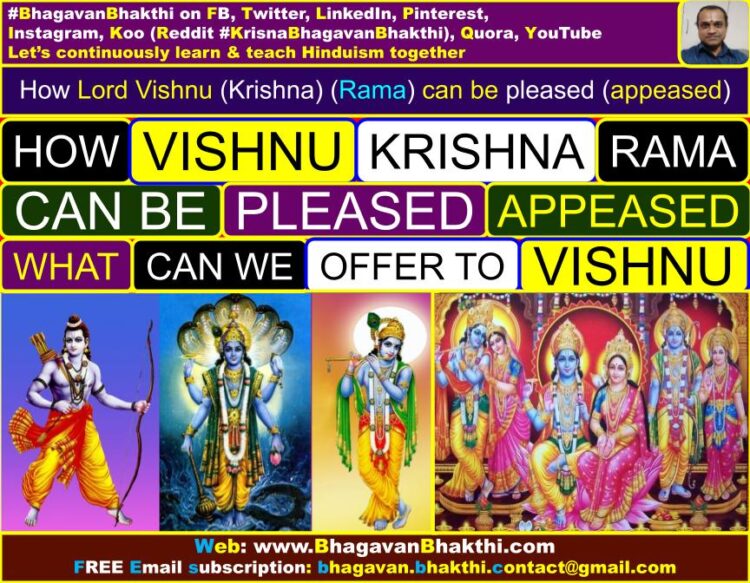
How to please (appease) Lord Krishna (Vishnu) (Rama) by taking an example from Bhagavad Gita: Bhagavad Gita is one of the most divine granthas (Hindu divine book) not only for Hindus, but for the whole world.
Just before the start of the Mahabharata (Kurukshetra) war, Bhagavan Lord Sri Krishna in the form of Gita (divine song) preaches this to his friend and great devotee Arjuna. But, we should always remember that Bhagavan Lord Sri Krishna not just preached the great Bhagavad Gita only to Arjuna. No, it’s not like that.
Bhagavan Lord Sri Krishna has preached the great Bhagavad Gita to all and especially to the Kali Yuga people as we lack the correct knowledge of Sanatana Dharma.
Thus, we should keep this in our mind that, Bhagavad Gita is for the wellbeing of all the living beings on earth. Bhagavad Gita = Bhagavan’s + Gita = Bhagavan Lord Sri Krishna preaches in the form of Gita (divine song) and thus the name Bhagavad Gita.
What is the meaning of the word ‘Bhagavad Gita’: Bhagavad = Bhagavan’s (God’s) + Gita (divine song). Bhagavad Gita was explained in the form a divine song. | Who said Bhagavad Gita: Bhagavan Lord Sri Krishna.
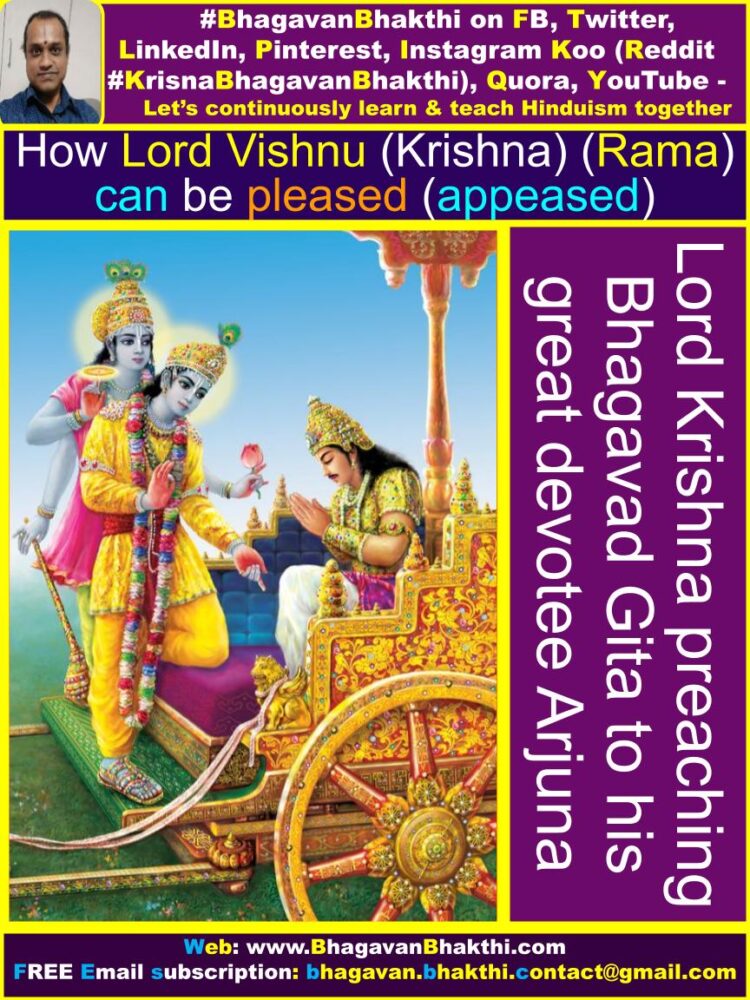
To whom Bhagavad Gita was said: To Arjuna – To be more accurate, the divine Bhagavan Gita is for everyone starting from Lord Sri Brahma to the last living being in the ‘Brahmanda’ (Universe). | Where was the Bhagavad Gita upadesha given: At a divine place called Kurukshetra.
When was this Bhagavad Gita upadesha was given: Approximately 3137 B.C | What can we learn by the study of Srimad Bhagavad Gita: Accurate, fundamental knowledge about Bhagavan (Vishnu / Krishna), the ultimate truth, creation, birth & death, the results of actions, the eternal soul, liberation and the purpose as well as the goal of human existence.
Now let us see the Bhagavad Gita shloka:
पत्रं पुष्पं फलं तोयं यो मे भक्त्या प्रयच्छति । तदहं भक्त्युपहृतमश्नामि प्रयतात्मनः ॥ ९-२६ ॥
ಪತ್ರಂ ಪುಷ್ಪಂ ಫಲಂ ತೋಯಂ ಯೋ ಮೇ ಭಕ್ತ್ಯಾ ಪ್ರಯಚ್ಛತಿ । ತದಹಂ ಭಕ್ತ್ಯುಪಹೃತಮಶ್ನಾಮಿ ಪ್ರಯತಾತ್ಮನಃ ॥ 9-26 ॥
Patraṁ puṣpaṁ phalaṁ tōyaṁ yō mē bhaktyā prayacchati। tadahaṁ bhaktyupahr̥tamaśnāmi prayatātmanaḥ॥ 9-26॥
Meaning of the sloka: patram = A single leaf; puspam = A single flower; phalam = A single fruit; toyam = water (little water); yah = Whoever; me = Give to Me (Sri Krishna); bhaktya = With full devotion; prayacchati = Offers;
tat = That; aham = I (Sri Krishna); bhakti-upahri’tam = Offered in true devotion; asnami = Accept; prayata-atmanah = Of one in pious consciousness.

Simple or outer meaning: If someone offers Me (Lord Sri Krishna) with pure love and devotion a single leaf or a single flower or a single fruit or little bit of water, I will definitely accept it and will surely save the devotee.
But here, Lord Sri Krishna has added a condition. What is that condition? – Only when a true devotee offers at least any one of these with pure and true devotion, then only he will accept what the devotee has offered.
And surely Lord Sri Krishna protects that devotee and certainly helps that devotee indisputably. This was the plain and/or superficial meaning of the Bhagavad Gita verse.
Now, let us know the inner meaning of this shloka: Doing Parayana (पारायण / ಪಾರಾಯಣ) / reading / recitation is like cooking. If we think we are going to cook a cumbersome and complex dish the first time itself and get it right, will it be practically correct? Can you please tell me?
We keep on practicing, missing some or the other ingredients every time, but we don’t stop trying. Until we finally get it right. Similarly while doing Parayana (पारायण / ಪಾರಾಯಣ) / reading / recitation and praying, we should do to our best possible way, keep on doing, keep on trying to the best of our possible level.
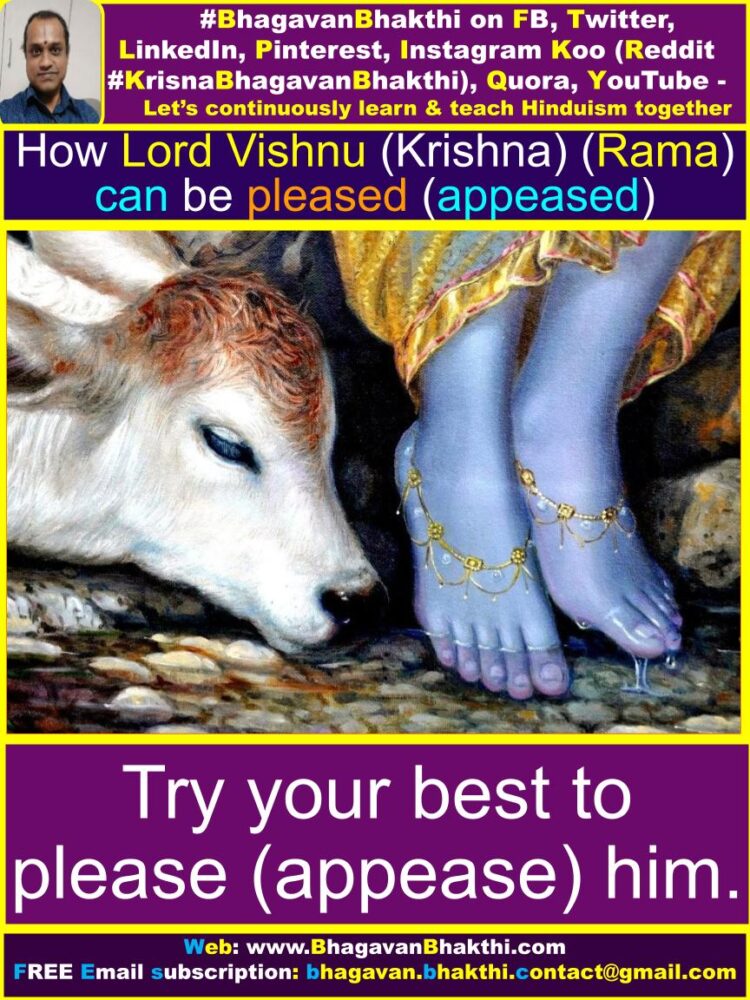
Bhagavan Lord Sri Vishnu (Krishna) doesn’t cares about the minor mistakes and thus we have to have confidence in him. To get the opportunity to do seva / serve / Parayana / praying itself takes several lives ‘Punya Karmas’ (Divine goods deeds).
We have to try to nullify our mistakes as much as possible. We should always remember that we are living in Kali Yuga and not in Satya Yuga. There is no 100% surety other than Bhagavan Lord Sri Vishnu (Krishna) in this gravely dangerous era of Kali Yuga.
Do we know how much ‘Punya Karma’ (Divine good deeds) we need to have to stay at any divine Vaishnava Devalaya (Divine Temple) for 7 days continuously and do Seva (Divinely serving)? Mostly all think, “What is special about it, I can do that Seva for 7 days”.
But these people are not able to do it, some or the other reason because of multiple reasons and obstacle which keeps emerging every now and then. It definitely takes a huge amount of ‘Punya Karma’ (Divinely good works), to get this opportunity to do seva (serve) at the Vaishnava temple.
We should always remember, when we get this chance, we have to grab it with wholeheartedly without a second thought. We need to always remember, Bhagavan Sri Vishnu (Krishna) is the only one who can give the guarantee of anything and everything.
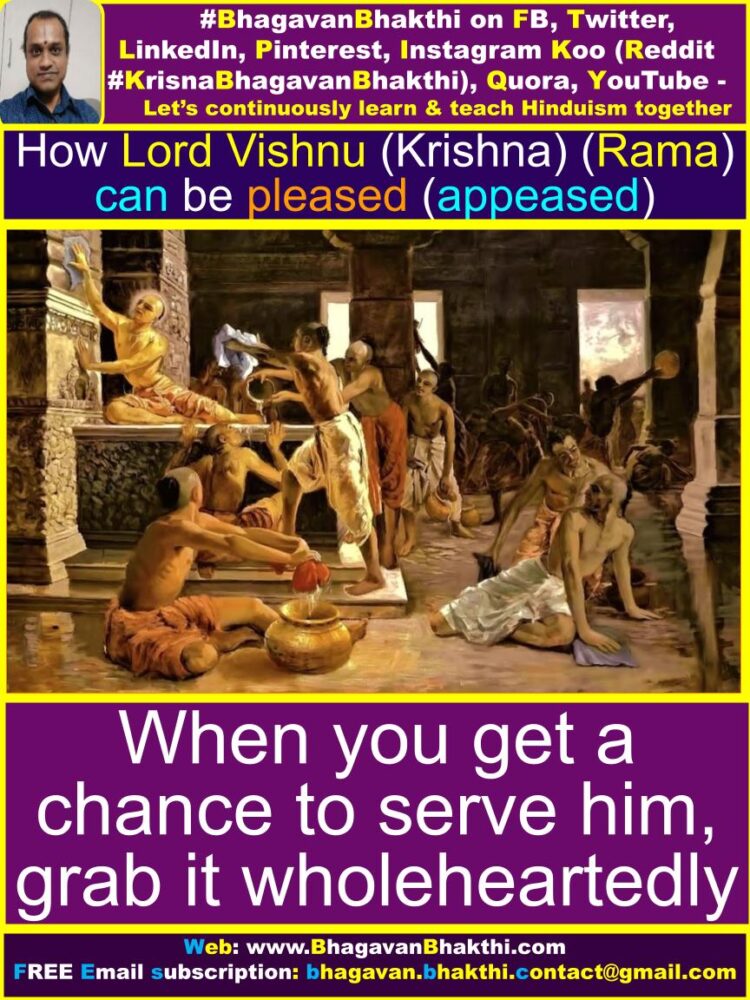
Thus we need not worry too much about others and other things and no need to waste any time now other than Lord Sri Krishna (Vishnu).
We need to have faith and devotion in him and need to do ‘dharmacharan’ (worship / daily rituals) on daily basis and sure we will get all the fruits as per our wishes, both material (mundane) and spiritual.
Let us take one good example from the divine and great epic of Mahabharata as given here: Once a divinely Brahmin (Brahmana) comes to meet the great King (Samrat) Yudhisthira (Samrat = Divine Empire) asking for daanam (Divine donation) for his son’s upanayanam (Divine work of God).
But, Samrat and King Yudhisthira asks the Brahmin (Brahmana) to come the next day as it was too late in the night. Thus the brahmin goes and meet the mighty Bhima. Here the mighty Bhima without any second thought immediately gives the daanam (Divine donation) and sends the brahmin with all respects.
Later, the great Bhima goes and makes sound of the ‘Victory Gong’ (A huge bell tied in the middle of the city, so that if anyone needs help then even the King has to come there and help that person at the earliest).

All people wake up, come there and asks him the reason for why Bhima is making the sound of the ‘Victory Gong’ in the middle of the night. The fearless Bhima says that, “Yudhisthira has conquered the death”.
Samrat and King Yudhishtira gets completely blank with these words of the Bhima.
Bhima explains like this: “By informing a Brahmin (Brahmana) to come tomorrow to meet him (Yudhishthira), my brother Samrat (Emperor) Yudhishthira indirectly acknowledges and he is sure that he is going to be alive the next day, that is, he has conquered death for the night and this is no small feat for him”.
Samrat Yudhishthira immediately understands this and realizes his mistake.
What is the moral of this story? – Work as if you won’t live another day. Whatever work you need to do the next day, do it today. Whatever the work you need to do after some time, do it now! This is the true meaning of this story.
Some people will be always thinking “I am working 10 hours a day, 11 hours a day, 12 hours day etc., I am in a foreign country, I am too busy, I have something coming up shortly & that work (I am talking about material things) has to be completely at the earliest, I can do it later” etc. etc. etc.

About doing the divine parayana properly and correctly, what is meant by: properly and correctly” here?
Now going back to the above shloka from the Bhagavad Gita, about “patram pushpam phalam toyam“: In the divine Bhagavad Gita, Bhagavan Lord Sri Krishna instructs each and everyone that, what is required is a simple “patram pushpam phalam toyam” just that’s all and nothing else.
Many people will go to market to buy leaves, flowers, fruits etc.
But what we actually required is as given here: Here, Patram means, the divine Hindu scriptures (Granthas), that is jnana from these Granthas. Pushpam means, we need to know the ‘mantra pushpam’ or ‘stotras’ or ‘Nama smaranam’ of Bhagavan Lord Sri Krishna (Vishnu) with real and true devotion.
Phalam means, we need to do the ‘Sat Karmas’ (Karmas in the right way). We should always remember the divine words of our Guru. For example my Guru is Sri Madhwacharya Ji words, “Naham Karta, Hari Karta” (Whatever I am doing is not done by me, but it is done by Bhagavan Lord Sri Vishnu / Sri Krishna).
Now, what is Toyam? Just water is it? – Hot water? Cold water? Fridge water? Plastic bottle water? Corporation tap water? Well water? Which water? None of the above.
Bhagavan Lord Sri Krishna (Vishnu) expects the divine tears of his true devotee. When we are doing the pooja of Bhagavan Sri Krishna (Vishnu) we should get the divine tears coming out of our eyes (not because of material expectations, but because of love and devotion towards Bhagavan Sri Krishna / Vishnu).
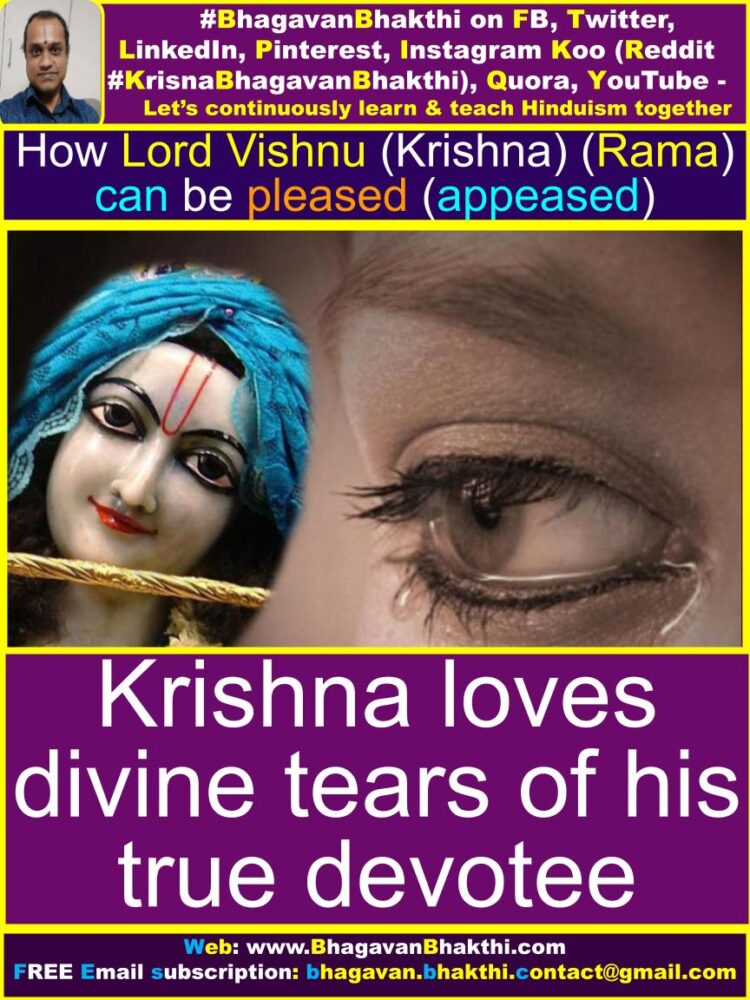
This the real and true ‘Toyam’ (water / tears) for Bhagavan Sri Krishna (Vishnu). Thus, we should always remember that, ‘the only person stopping you from doing Parayana’ is yourself and no one else.
At least now we have to wake up from the material expectation, material joy etc. We have to do ‘pathana’ (पठान / ಪಠಣ) / read of our divine granthas (texts) from today and now itself.
This doesn’t means that we shouldn’t use the real leaves, flowers, fruits and water for the pooja of Bhagavan Sri Krishna. We should use all these, but we should always remember the above given knowledge.
If we don’t do it today and now, we will definitely won’t do anytime in the future too. This is 100% sure and truth.
How to please (appease) Lord Krishna (Vishnu) (Rama) by fasting on Sri Krishna Janmashtami : A great way to please Lord Vishnu (Krishna) is to fast on Krishna Janmashtami day irrespective of varna, caste, color, creed etc.
Fasting needs to be observed 24 hours before Lord Krishna’s birthday (Janmashtami), which took place at midnight. Pujas and rituals will be held from around 23:00 Hrs on Krishna Janmashtami day.
Parana i.e. partaking food should be done the next day soon after the Suryodaya (Sunrise) after the pooja of Lord Krishna (Vishnu). By once fasting on Krishnashtami, a person becomes free from the sins of seven births.
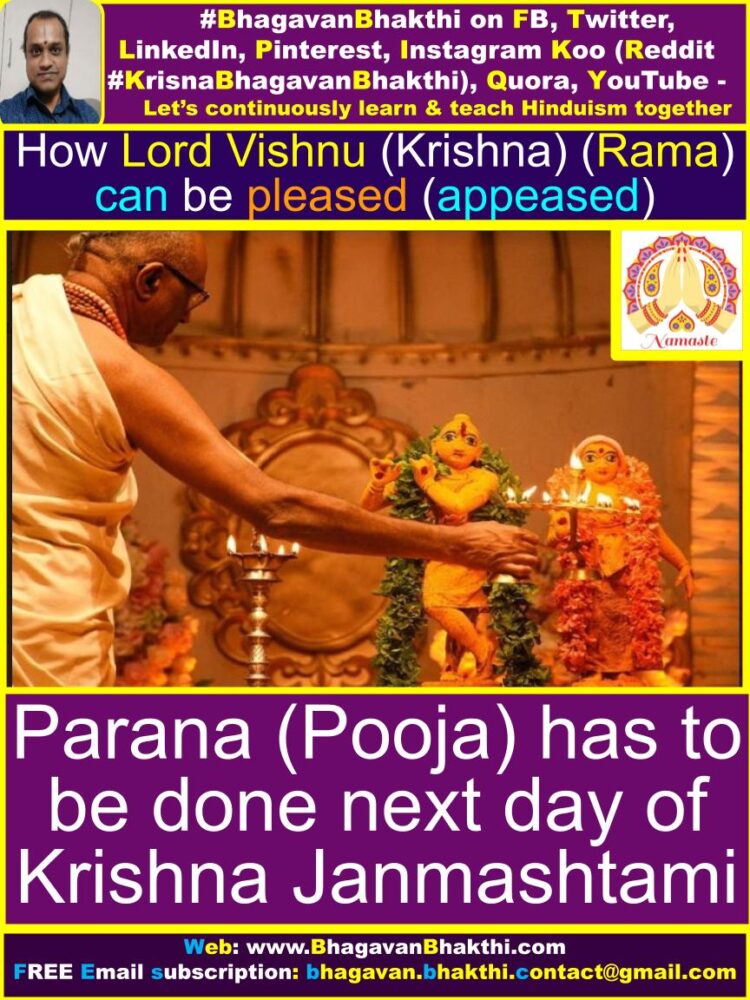
Benefits of fasting on Krishna Janmastani is as given here : One gets the merit of giving a thousand cows as charity. | You will get the merit of giving millions of jewels in charity. | You will get the merit of building many temples. |
In this fast you get the merits of serving parents and Guru with highest devotion. | Goddess Lakshmi always dwells among the great souls who fast on Krishnashtami day.
There is nothing equal or superior to fasting on Sri Krishna Janmashtami as said in Vedas and Puranas. Descendants who fast become righteous. Thos people will get excellent health and unequaled fortune throughout his/her life.
That person becomes devoted towards truth and dharma and when he dies, he goes directly to Vaikuntha, the abode of Lord Vishnu (Krishna). That person’s words become the home of many virtues.
One who does not fast on Krishna Janmashtami violates the rules of Sanatana Dharma. A person who casually observes the Krishnashtami fast also goes to the spiritual world of Lord Vishnu (Krishna) Vaikuntha. Of course, there is no doubt about this.
One who worships Lord Vishnu (Krishna) washes away all his / her sins, big or small, or sins committed in childhood, youth or old-age or at any age or in your last births. That person will multiply the results of great and divine homas, yajnas and donations a hundredfold.
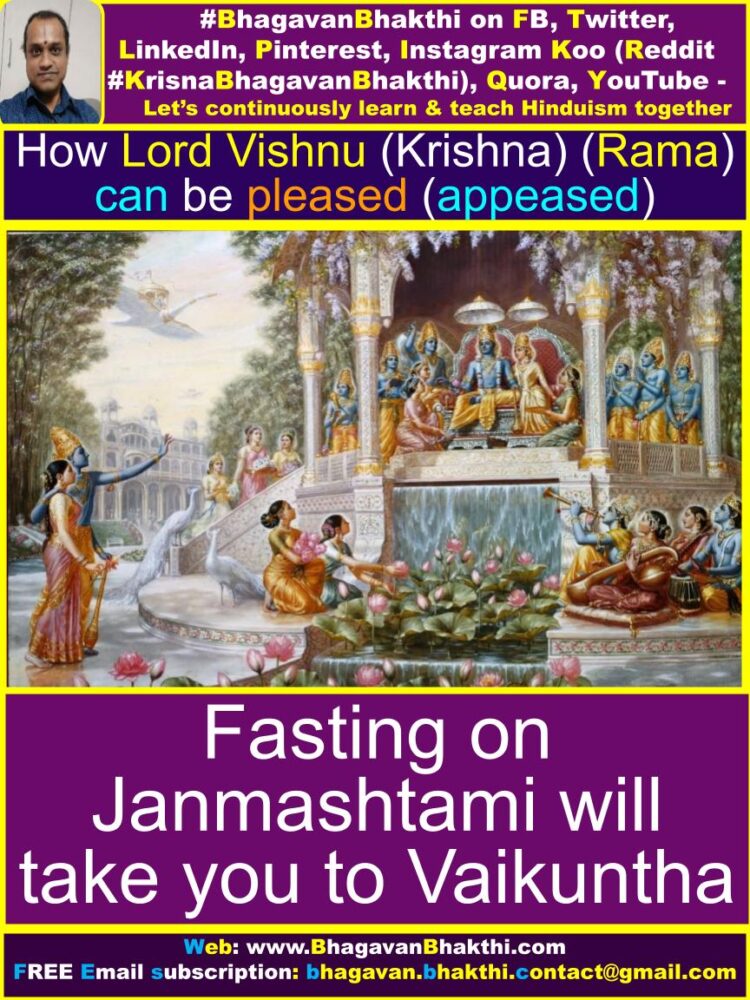
That person achieves what his heart desires. A person who fasts on this day is freed from major sins. Bathing, charity, homa, Vedadhyana, japa and austerities performed on Krishnashtami (Janmashtami) day when they are done to please or appease Lord Vishnu are multiplied a hundredfold.
The whole day should be spent in reading and/or listening to scriptures like Bhagavad Gita, Srimad Bhagavata, Mahabharata, Ramayana etc.
NOTE : All the above descriptions (Glories of Lord Sri Krishna and Janmashtami Fasting) are highly confidential and hidden in Hindu scriptures and not available to all human beings. Only a true devotee of Lord Sri Krishna (Vishnu) can fast on Krishna Janmashtami.
How to please (appease) Lord Sri Vishnu (Krishna) (Rama) by doing Arti or Mangala Arti is as given here: Arti (आरति) (ārati) or Mangala Arti (मन्गल आरति) (maṅgaḷa ārati) is also written as Aarti or Mangalarati or Mangala Aarati or Mangal Arti or Mangal Arati etc. Let us use Arti or Mangala Arti in this discussion.
Arti is derived from the Sanskrit word Aratrika (आरात्रिक) (ārārtika), which means something that removes Ratri, that is, darkness in our life. Here Aratrika = A + ratri + ka = Removes + darkness + doer = It removes the darkness in our life permanently.
Mangala Arati means = Mangala + Arati = Highly auspicious arti, which removes the darkness from our life permanently.
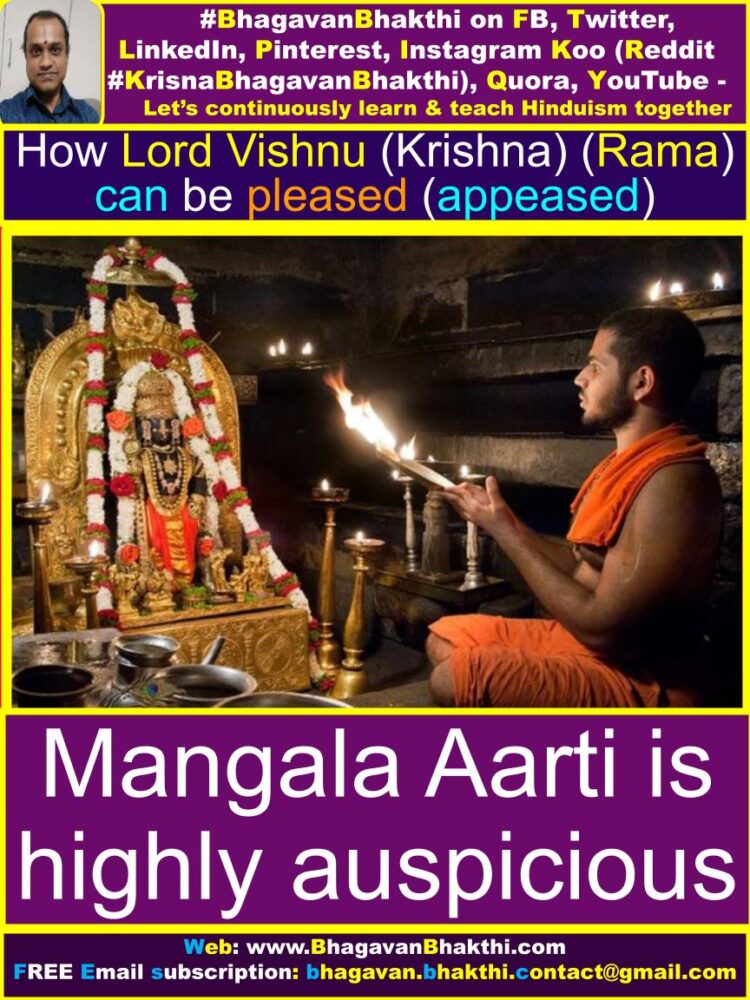
Other meanings of Mangala Arti – The word Mangala means “divinely auspiciousness”. The word manga means – gati (there is no one other than you – Krishna / Vishnu). This means ‘chalana’ (life movements) or ज्ञान (jñāna) (gyan) (knowledge) and laati = bestows.
Vishnu (Krishna) is the one who provides the helping hand to us (life movements) and also he is the one who bestows the divine knowledge (ज्ञान) (jñāna) (gyan) to us through our life (until we are the devotee of Vishnu / Krishna).
The Lord Vishnu (Krishna) bestows all the living entities (more on his devotees) the capacity to perform life actions and to achieve the unachievable. Also, Lord Krishna (Vishnu) bestows the knowledge to every one as per yogyata (ability).
Arati – A = samantAt (completely as per ability or as needed as per ability), rati = sukha or blissfulness. Niraajana – Nira = water – again referring to Lord Sri Vishnu (Krishna) who leads us to ajana = birthless state (providing Moksha / Mukti / final liberation).
Arti or Aarti is said to be derived from the Vedic concept of Agni (fire) rituals or Homa. The incense that comes out of the arti (aarti) represents a purified state of mind and one’s “wisdom” is imparted through adherence to the rules of timing and order of offerings.
Thus, one’s entire existence and all aspects of material creation are symbolically offered to the Lord Vishnu (Krishna) through the Arti ceremony. The term may also refer to a traditional Hindu devotional song sung during a Arti or Mangalarati ritual.
The Arti plate is usually made of metals like silver, bronze or copper. One or more cotton wicks (always an odd number) are dipped in pure tila (sesame) oil or ghee and then lit or camphor is burnt instead. The plate may also contain flowers, incense and akshata (rice).
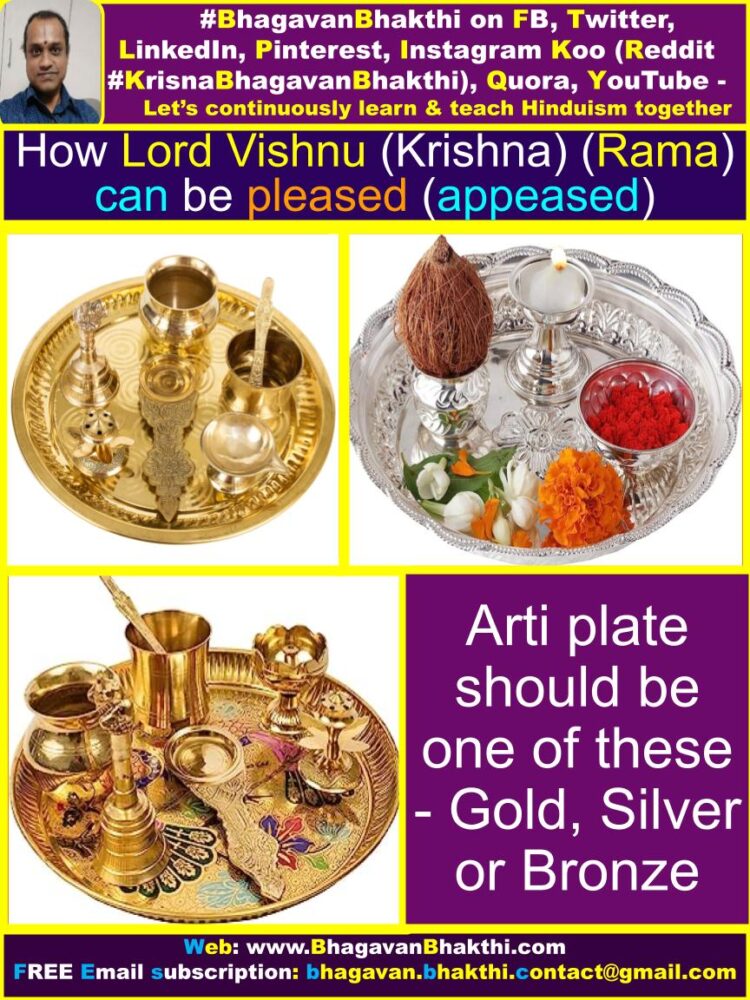
(Here incense means not the agarbatti which is sold in the market. But, you need to find out pure incense and the same has to be used instead of the impure agarbatti which are available in the market.)
Purpose of Arti – The purpose of performing Arti or Aarti is to wave lighted wicks before the deities in a spirit of humility and gratitude, wherein the devout followers immerse themselves in the God (Vishnu / Krishna) or Devatas (Demigods) in divine form.
Arti (Aarti) symbolizes five elements: Akasha (Ether), Vayu (Wind), Agni (Fire), Jala (Water) and Prithvi (Earth).
Let us consider another story from Varaha Purana (Ashvashira’s unification with Lord Narayana / Vishnu) as given below:
Once Goddess Prithvi Devi (mother earth) asked Bhagavan Lord Sri Varaha (one of the avatar of Bhagavan Lord Sri Vishnu) about the famous incident which described Ashvashira’s unification with Lord Narayana / Vishnu.
Bhagavan Lord Varaha then narrated the following tale to Goddess Prithvi: “During ancient times, there used to live a virtuous king named Ashvashira. He had performed an ‘Ashwamedha Yagya’ in which he had donated large amount of wealth.
Once, Sage Kapila arrived at his palace accompanied by Sage Jaigishavya. King Ashvashira received both his distinguished guests with due honour.

After the formalities were over, he asked both his guests about the means by which Lord Narayana (Vishnu) can be pleased and also about the rituals pertaining to the worship of Lord Narayana.
Both the sages being enlightened souls realized that Ashvashira was asking this question out of his ignorance. So, they decided to enlighten him on the omnipresent nature of Bhagavan Narayana (Vishnu) and said like this –
‘What do you mean by pleasing Bhagavan Narayana? Can’t you see two Narayanas standing in front of you?’
But, Ashvashira was unamused and unconvinced so he replied – ‘I don’t deny that both of you possess supernatural powers and also that all your sins have destroyed on account of the virtues attained by doing penance.
But, I don’t believe your claim to be Bhagavan Narayana. Bhagavan Narayana is the almighty God and the supreme deity. He holds a conch, a chakra and a mace in his hands. He wears pitambara (golden yellow dress) and has Garuda as his mount. His glory is indescribable and incomparable.
As Ashvashira had raised valid points, Sage Kapila transformed his appearance to Lord Vishnu with the help of his divine powers. Similarly, Sage Jaigishavya transformed his appearance and became Garuda.
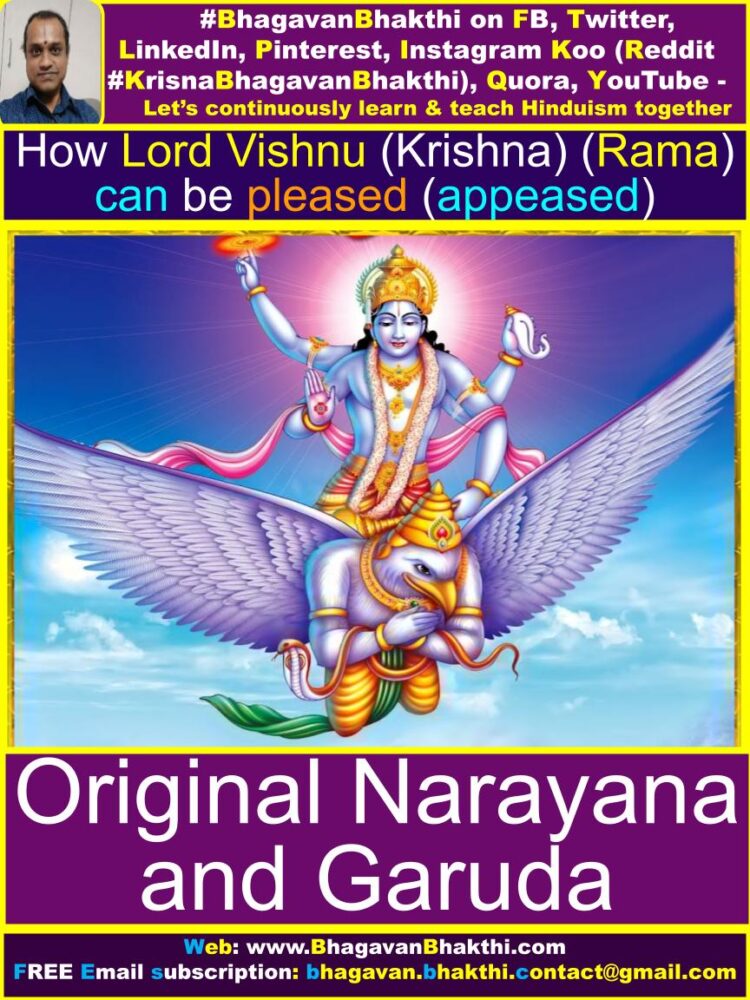
But, Ashvashira still remained unconvinced and said – ‘How can I accept you to be Bhagavan Narayana as there is no sign of lotus manifesting from your navel in which Lord Brahma has his abode.’
Sage Kapila then slightly transformed his appearance and created an illusion where by a lotus flower emanating from his navel became visible to Ashvashira.
Sage Jaigishavya sat on that lotus flower in the guise of Lord Brahma. Not only that, they also created an illusion due to which all types of living creatures inside the palace premise.
Now, Ashvashira was really confused and requested both the Sages to break the magic spell. Both the Sages decided not to test the limit of Ashvashira’s patience and so, they transformed their respective guises into their original appearances.
Both of them said – ‘Bhagavan Narayana is one, but can manifest himself in countless forms. The whole universe is HIS creation and HE is present in every single creature.’
‘It is impossible for a mortal being to bear the radiance of almighty Bhagavan Narayana and it is only when HE appears in his more gentle form that the enlightened person is able to see him.’
‘Therefore, you should engage yourself in the service of mankind, considering each human being to be the medium through which Bhagavan Narayana manifests himself.’
Ashvashira was satisfied by the explanation given by both the Sages, but there was still one question bothering him a lot, so he asked – ‘Who is most likely to attain salvation (moksha) – a knowledgeable person or a person who indulges in rightful deeds?

Sage Kapila narrated the following tale – ‘Once, Sage Raimya and King Vasu had asked the same question to Sage Brihaspati.’
‘At that time great Guru of the Devatas (Demigods) Sage Brihaspati had replied that anybody who performed his duties with a sense of detachment (nishkama) is sure to attain salvation and to prove his point he had narrated the following tale –
‘During ancient times, there lived a brahmin named Sanyamana. He was the descendant of Sage Atri, the father of Lord Dattatreya. One day, while he was going to take his bath he met Nishthoora – a fowler, who used to catch birds and animals for his livings.’
Sanyamana reprimanded Nishthoora for his evil deeds and said – Why do you trap innocent birds and animals?
Nishthoora replied- ‘The almighty God Vishu is present in each living creature. One who is desirous of attaining salvation must under no circumstances allow his ego to dominate him.
The ‘doer’ is not the man but the supreme Almighty present inside him as ‘antaryami’. Keeping this fact in his mind a man should perform his duties with no challenge and a sense of detachment. If I earn my livelihood by catching birds and animals then it is the will of almighty’.
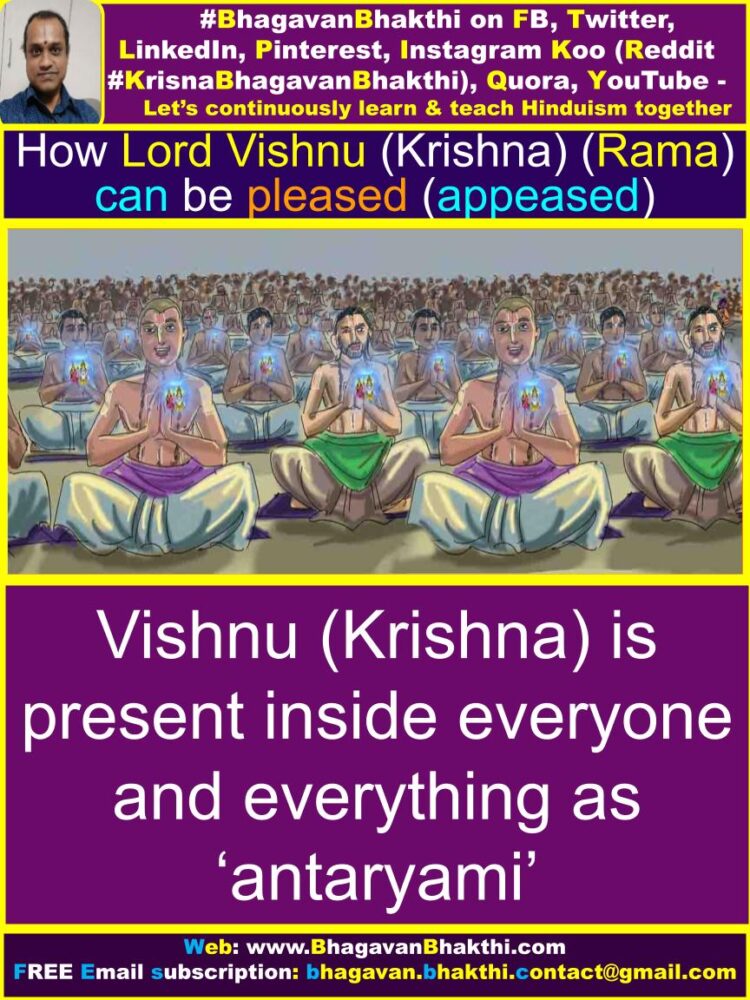
To prove his point, the fowler spread his iron-net and kept dry blocks of wood underneath it and then requested Sanyamana to ignite those blocks. Sanyamana was surprised but burnt the wooden logs as per the fowler’s instruction.
In a short time all the wooden blocks became ablaze and the flames started coming out from the thousand of small holes of the iron-net.
The fowler then told Sanyamana that although the flames coming from each hole appeared to have distinct sources, yet the fact was that the flames manifested from the single source – wooden blocks that were burning beneath the iron-net.
The fowler said – “It was impossible to extinguish the fire until and unless the source of the fire was extinguished. Each hole of the iron-net can be compared with an individual and the almighty God with the source of fire.”
“A man does what God wills and he can never experience sorrow provided he constantly remembers (chanting his names of Lord Vishnu / Krishna) the Almighty even while he is performing his daily chores”.

Sanyamana was very much impressed by the fowler’s wisdom. Having finished his tale, Sage Brihaspati told Raimya –
“Now it must be evident to you that salvation is within the reach of any individual. It does not make much difference whether the seeker of salvation is a householder or a hermit aspiring for knowledge.”
Continuing with the story of Ashvashira, Bhagavan Varaha Svami told Goddess Prithvi Devi – “King Ashvashira was so impressed by Sage Kapila’s preachings that he went to Naimisharanya and spent his rest of his life in the service of Bhagavan Narayana (Vishnu).
Once, while he was performing yagya, suddenly Bhagavan Vishnu (Narayana) manifested himself from the altar in the form of a brilliant effulgence and the identity of Ashvashira merged with it. This way, Ashvashira got united with Bhagavan Vishnu (Narayana) by the virtue of his deep devotion.
Note: It must be noted, that everybody has been given a particular job and that particular job has to be done by that particular person itself. The meaning of the above story is not that killing innocent animals is correct according to our Sanatana Dharma.
But a hunter’s job is hunting, similarly a Brahmana’s job is teaching, a Kshatriya’s job is protecting, a Vaishya’s job is business and a Shudra’s job is supporting all the other varna people. We need to perform our both mundane and spiritual works and nothing else.

To know the real meaning of the “Chatur Varna” (four Varna) in our GREAT SANATANA DHARMA, you can visit my other post. The link of that post is as here: Four varna Chatur varna correct meaning
Continue reading more information about Hindu Puranas from here : Information and significance of Hindu Puranas
More information will be added to this on regular, please visit after some time to know more information.
To watch videos on #Hinduism #Sanskrit language, SUBSCRIBE to my YouTube channel from this below link:
#BhagavanBhakthi YouTube channel
Dear friends, if you need any clarifications about this post, kindly let me know, I will definitely try to answer all of them.
Also your one LIKE, one COMMENT, One Share, one SUBSCRIPTION is highly important.
This will help to know the quality of this content and also it will be helpful to know if any improvements is required for the content.
If you feel this content is useful to you and has helped you to improve your knowledge, kindly share this with your well-wishers.
Because “SHARING MEANS CARING”.
For receive FREE EMAIL SUBSCRIPTION about #BhagavanBhakthi, you can send an email to [email protected] from your email ID.
NAMASTE!
Sri Gurubhyo Namaha
OM NAMO NARAYANAYA
Sri Krishnaarpanamastu
Share in Social Media